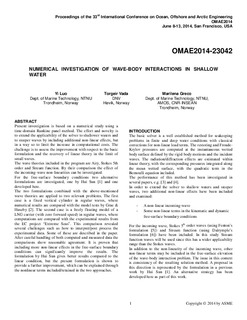| dc.contributor.author | Luo, Yi | |
| dc.contributor.author | Vada, Torgeir | |
| dc.contributor.author | Greco, Marilena | |
| dc.date.accessioned | 2017-12-08T12:07:27Z | |
| dc.date.available | 2017-12-08T12:07:27Z | |
| dc.date.created | 2017-12-06T16:32:25Z | |
| dc.date.issued | 2014 | |
| dc.identifier.isbn | 978-0-7918-4550-9 | |
| dc.identifier.uri | http://hdl.handle.net/11250/2469776 | |
| dc.description.abstract | Present investigation is based on a numerical study using a time-domain Rankine panel method. The effort and novelty is to extend the applicability of the solver to shallower waters and to steeper waves by including additional non-linear effects, but in a way so to limit the increase in computational costs. The challenge is to assess the improvement with respect to the basic formulation and the recovery of linear theory in the limit of small waves.
The wave theories included in the program are Airy, Stokes 5th order and Stream function. By their comparison the effect of the incoming-wave non-linearities can be investigated.
For the free-surface boundary conditions two alternative formulations are investigated, one by Hui Sun [1] and one developed here.
The two formulations combined with the above-mentioned wave theories are applied to two relevant problems. The first case is a fixed vertical cylinder in regular waves, where numerical results are compared with the model tests by Grue & Huseby [2]. The second case is a freely floating model of a LNG carrier (with zero forward speed) in regular waves, where computations are compared with the experimental results from the EC project “Extreme Seas”. This comparison revealed several challenges such as how to interpret/post process the experimental data. Some of these are described in the paper. After careful handling of both computed and measured data the comparisons show reasonable agreement. It is proven that including more non-linear effects in the free-surface boundary conditions can significantly improve the results. The formulation by Hui Sun gives better results compared to the linear condition, but the present formulation is shown to provide a further improvement, which can be explained through the nonlinear terms included/retained in the two approaches. | nb_NO |
| dc.language.iso | eng | nb_NO |
| dc.publisher | American Society of Mechanical Engineers (ASME) | nb_NO |
| dc.relation.ispartof | ASME 2014 33rd International Conference on Ocean, Offshore and Arctic Engineering, Volume 8A: Ocean Engineering | |
| dc.title | Numerical Investigation of Wave-Body Interactions in Shallow Water | nb_NO |
| dc.type | Chapter | nb_NO |
| dc.type | Peer reviewed | nb_NO |
| dc.description.version | publishedVersion | nb_NO |
| dc.identifier.doi | 10.1115/OMAE2014-23042 | |
| dc.identifier.cristin | 1523778 | |
| dc.description.localcode | (c) 2014 by ASME | nb_NO |
| cristin.unitcode | 194,64,20,0 | |
| cristin.unitcode | 194,64,80,0 | |
| cristin.unitname | Institutt for marin teknikk | |
| cristin.unitname | Senter for autonome marine operasjoner og systemer | |
| cristin.ispublished | true | |
| cristin.fulltext | postprint | |
| cristin.qualitycode | 1 | |
